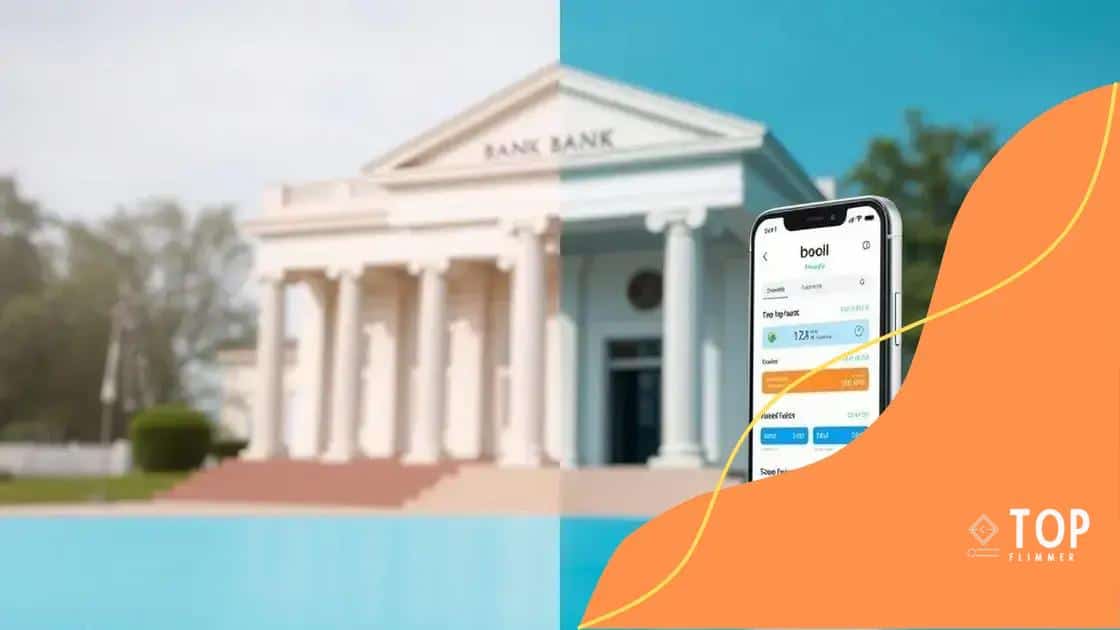Digital banking: Is this the end for traditional banks?

Digital banking is revolutionizing financial management by offering 24/7 access, lower fees, and enhanced convenience, while fintech companies drive innovation and challenge traditional banking models.
Digital banking is changing more than just how we handle money; it’s reshaping the entire banking landscape. Have you ever wondered how traditional banks are coping with this shift? Let’s dive into the transformation!
Understanding digital banking
In the current financial landscape, digital banking is becoming increasingly popular. Understanding this shift is crucial for anyone looking to manage their finances effectively. Digital banking offers convenience and ease of access like never before.
What is digital banking?
Digital banking refers to the use of online platforms and mobile applications to conduct banking activities. This includes tasks such as checking account balances, transferring money, and managing investments, all from the comfort of home.
Key Features of Digital Banking
- 24/7 access to your accounts
- Easy money transfers with just a few clicks
- Tools for budgeting and tracking spending
- Enhanced security measures for online transactions
The features above make digital banking appealing to many users. Traditional banking methods often require a visit to a physical branch, which can be time-consuming. With digital banking, everyday banking tasks can be done quickly.
Moreover, mobile banking apps provide functionalities that traditional banks may not offer, such as instant notifications for account activities. This helps users stay informed about their finances in real-time.
Benefits of Understanding Digital Banking
By understanding how digital banking works, you can take full advantage of its offerings. Familiarity with digital tools enables better financial management and encourages smarter spending habits.
In addition, knowing how to navigate these platforms can lead to discovering personalized recommendations, tailored specifically for your financial needs. This tailored experience is often missing in traditional banking setups.
Recognizing the potential of digital banking can help you make informed decisions about your finances. As technology continues to evolve, staying updated will ensure you make the most of every opportunity.
The rise of fintech companies
The rise of fintech companies is reshaping the financial landscape. These innovative firms are changing how we think about banking and finance, making services more accessible to everyday people.
What are Fintech Companies?
Fintech refers to technology-driven companies that provide financial services. They offer solutions such as online banking, payment apps, budgeting tools, and crowdfunding platforms. By using advanced technology, they streamline processes and improve user experiences.
Benefits of Fintech Solutions
- Lower fees compared to traditional banks
- Faster transactions with minimal paperwork
- Personalized financial guidance through apps
- Access to a range of financial products in one place
As you explore the world of fintech, you’ll notice that these companies often prioritize user experience. Apps are designed to be intuitive, allowing even those unfamiliar with finance to navigate easily. This focus on usability makes financial management simpler.
Moreover, fintech innovations have led to greater financial inclusion. Individuals who may not have access to traditional banking services can now participate in the financial system. This means resources are available to more people, reducing barriers to entry.
Impact on Traditional Banking
The rise of fintech companies is also challenging traditional banks. As customers turn to digital solutions, established banks may struggle to keep up with changing demands. Many banks are now investing in technology to enhance their services and stay competitive.
This shift creates an exciting opportunity for consumers. With various options available, users can choose services that best meet their needs. In the end, the competition between fintech and traditional banks may lead to better products and services for everyone.
Comparing digital banks and traditional banks

When it comes to managing finances, understanding the differences between digital banks and traditional banks is essential. Each offers unique benefits and challenges that can impact your banking experience.
What are Traditional Banks?
Traditional banks have been around for decades. They usually have physical branch locations where customers can meet with staff, make deposits, and receive personal service. While they offer full-service banking with loans, mortgages, and financial advice, customers often need to visit a branch for many transactions.
What are Digital Banks?
Digital banks, on the other hand, operate mainly online. They do not have physical locations, so all transactions occur through websites or mobile apps. This setup allows for lower costs, making services cheaper for customers. However, it often means less personal interaction.
Key Differences
- Accessibility: Digital banks offer 24/7 access to accounts from anywhere with an internet connection, while traditional banks may have limited hours.
- Fees: Digital banks typically charge lower fees compared to traditional banks, which can have various charges for services.
- Customer Experience: While traditional banks provide face-to-face interaction, digital banks offer a faster, more efficient experience online.
- Services Offered: Both types of banks can provide similar products, but traditional banks may offer a broader range of financial advice and personalized services.
Understanding these differences can help customers choose the right banking option for their needs. For example, if you value convenience and lower fees, a digital bank may be more suitable. If personalized service and comprehensive financial advice are priorities, a traditional bank might be a better fit.
Moreover, the rise of hybrid banking solutions is blurring these lines. Some traditional banks are now offering online services, while digital banks are starting to provide limited in-person options. This trend means there are even more choices for customers looking for flexible banking solutions.
Customer experience in digital banking
The customer experience in digital banking has become a key focus for financial institutions. With more people choosing to bank online, understanding this experience is crucial for success.
Elements of Customer Experience
Digital banks aim to provide a seamless experience. Key elements that contribute to this include user-friendly interfaces, quick service, and accessibility. Customers expect to navigate their accounts easily through apps or websites, which enhances satisfaction.
User-Friendly Interfaces
A crucial part of the customer experience is the design of digital banking interfaces. An intuitive layout helps users complete transactions swiftly. Customers often appreciate features like simple navigation menus and easily identifiable icons, which make their banking experience stress-free.
Quick and Efficient Service
Speed plays a significant role in customer experience. Digital banks typically offer faster transaction times compared to traditional banks. For example, customers can send money, pay bills, and transfer funds within seconds. This efficiency can significantly improve customer satisfaction.
Accessibility and Support
- 24/7 access to banking services
- Live chat support for immediate assistance
- Mobile notifications for account activities
- User guides and tutorials for better navigation
Moreover, the accessibility of digital banking services allows customers to conduct banking activities at their convenience. With around-the-clock access, users can manage their finances whenever they want, eliminating the need for urgent trips to the bank during business hours.
Furthermore, many digital banks offer various support options. Live chat and online help centers provide customers with immediate assistance, making problem-solving faster and more efficient. This level of support enhances the overall experience and builds trust between the bank and its customers..
As the landscape of banking evolves, these factors will shape how customers perceive digital banking. A bank’s ability to adapt and meet customer expectations will ultimately determine its long-term success in the competitive market.
Future trends in banking
The future of banking is evolving quickly, driven by technology and changing consumer expectations. Understanding these future trends can help users and banks alike prepare for what lies ahead.
Emphasis on Digital Transformation
As digital banking gains popularity, banks are prioritizing digital transformation. This means investing in technology to streamline services and improve customers’ experiences. Banks are emphasizing mobile apps, online account management, and faster transaction processes to meet consumer needs.
Rise of Artificial Intelligence
Artificial Intelligence (AI) is becoming integral to banking. Banks use AI to analyze customer data and offer personalized services. AI chatbots are available 24/7, assisting customers with questions and transactions at any time. This level of support enhances the customer experience and increases satisfaction.
Increased Focus on Security
As more people turn to digital banking, cybersecurity becomes a top priority. Banks are implementing advanced security measures to protect sensitive information. Innovations such as biometrics and encryption technology safeguard customer data, helping to build trust in digital banking platforms.
- Multi-factor authentication for additional security
- Real-time transaction monitoring to detect fraud
- Enhanced customer education on security best practices
- Regular security updates and improvements
Alongside these technological advancements, banks are also adapting their products and services to cater to evolving consumer preferences. For instance, eco-friendly banking options are gaining traction as customers become more conscious of their environmental impact.
The fintech sector continues to influence traditional banking, pushing institutions to innovate and remain competitive. Collaborations between banks and fintech companies lead to more dynamic offerings, combining the reliability of traditional banking with the innovation of new technology.
Overall, the insight into these future trends in banking signals a shift towards a more integrated and user-friendly financial landscape. Embracing these trends can lead to better services and greater customer satisfaction in the years to come.
FAQ – Common Questions About Digital Banking
What are the main benefits of digital banking?
Digital banking offers convenience, allowing users to access their accounts 24/7 from anywhere, and often lower fees compared to traditional banks.
How do fintech companies impact traditional banks?
Fintech companies introduce innovative solutions and technologies that challenge traditional banks to improve their services and adapt to new consumer needs.
What security measures are in place for digital banking?
Digital banks use advanced security features such as encryption, biometrics, and multi-factor authentication to protect customer information.
Will traditional banks disappear due to digital banking?
While traditional banks are adapting to digital trends, they are unlikely to disappear. Instead, they will evolve by incorporating digital solutions alongside their existing services.






